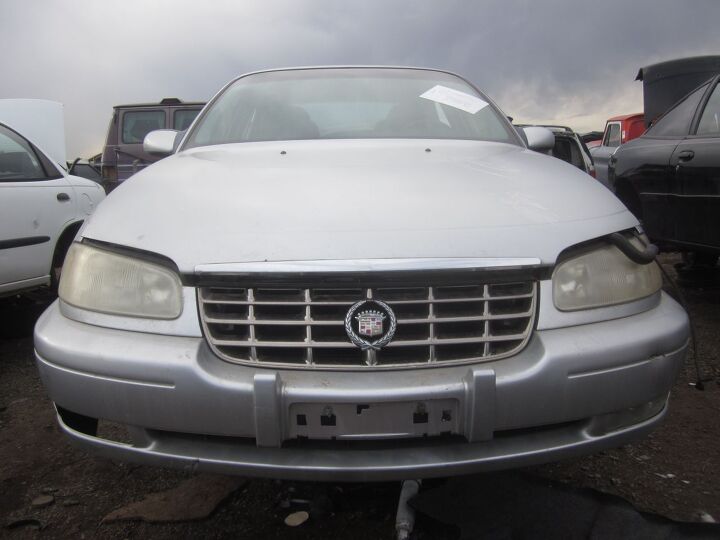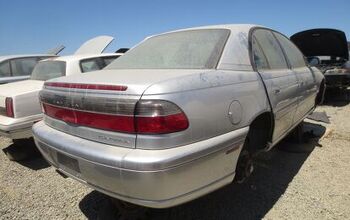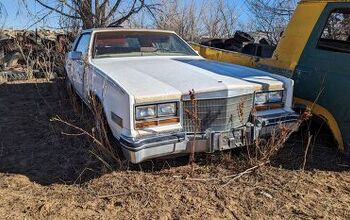Junkyard Find: 1998 Cadillac Catera

By the mid-1990s, The General’s top thinkers had finally figured out that 90-year-olds don’t have many car-buying years left in them, which meant that Cadillac had to convince some sub-nonagenarians to buy their cars. Naturally, the focus of this effort would be more on marketing than on the vehicles themselves, but even Cadillac’s most PowerPoint-adept marketing wizards knew that they couldn’t slap Day-Glo orange “Brougham d’Elegance EXTRËËMË ËDITION” badges on the Eldorado ETC, hire Napalm Death as celebrity spokesmen, and expect hip/well-heeled 30-somethings to ditch their imports. No, a different kind of Cadillac would be needed. Hey, how about slapping some Cadillac emblems on the Opel Omega? Problem solved!
So, here comes Ziggy the Catera Duck. Inspired by the ducks on the Cadillac emblem (which originated in the crest of French explorer Antoine Laumet de La Mothe, sieur de Cadillac), Ziggy would show that you didn’t need blue hair or an oxygen tank to drive a Cadillac. Ziggy was proof that the Cadillac-badged Omega— called the Catera— was for young folks!
Well, it didn’t work. As Chrysler learned in most vivid fashion with the Neon’s marketing campaign, cute doesn’t sell cars to Americans. It turns out that you need 500+ horsepower in an evil-looking wrapper to erase decades of geriatric brand-image damage (with the notable exception of the Escalade, which lucked into acceptance by young American rappers), because Americans hit ’em hard!
I had just about forgotten about the Catera, except for the occasional jeremiad I’ve issued to 24 Hours of LeMons racers demanding a Catera (or Allanté) race car, but then I found this fairly solid example in my local self-serve junkyard. This is the first Catera I’ve ever seen in a junkyard, which says more about the Catera’s rarity than of its reliability.
GM’s history of selling Opels in the United States hasn’t been a happy story, though the case could be made that the big-selling Chevette was really an Opel. The Catera’s ad campaign flopped, the engines tossed timing belts in all directions, and veterans of Belleau Wood continued to buy “real” Cadillacs.
The Omega B really wasn’t a bad design (as owners of the Opel-via-Holden-based 2004-06 GTO will tell you), and it might have sold better through another GM division with a different marketing approach. As it sorted out, though, the Catera has become another interesting cul-de-sac of automotive history, the sort of thing best explored via Junkyard Finds.

Murilee Martin is the pen name of Phil Greden, a writer who has lived in Minnesota, California, Georgia and (now) Colorado. He has toiled at copywriting, technical writing, junkmail writing, fiction writing and now automotive writing. He has owned many terrible vehicles and some good ones. He spends a great deal of time in self-service junkyards. These days, he writes for publications including Autoweek, Autoblog, Hagerty, The Truth About Cars and Capital One.
More by Murilee Martin
Latest Car Reviews
Read moreLatest Product Reviews
Read moreRecent Comments
- W Conrad I'm not afraid of them, but they aren't needed for everyone or everywhere. Long haul and highway driving sure, but in the city, nope.
- Jalop1991 In a manner similar to PHEV being the correct answer, I declare RPVs to be the correct answer here.We're doing it with certain aircraft; why not with cars on the ground, using hardware and tools like Telsa's "FSD" or GM's "SuperCruise" as the base?Take the local Uber driver out of the car, and put him in a professional centralized environment from where he drives me around. The system and the individual car can have awareness as well as gates, but he's responsible for the driving.Put the tech into my car, and let me buy it as needed. I need someone else to drive me home; hit the button and voila, I've hired a driver for the moment. I don't want to drive 11 hours to my vacation spot; hire the remote pilot for that. When I get there, I have my car and he's still at his normal location, piloting cars for other people.The system would allow for driver rest period, like what's required for truckers, so I might end up with multiple people driving me to the coast. I don't care. And they don't have to be physically with me, therefore they can be way cheaper.Charge taxi-type per-mile rates. For long drives, offer per-trip rates. Offer subscriptions, including miles/hours. Whatever.(And for grins, dress the remote pilots all as Johnnie.)Start this out with big rigs. Take the trucker away from the long haul driving, and let him be there for emergencies and the short haul parts of the trip.And in a manner similar to PHEVs being discredited, I fully expect to be razzed for this brilliant idea (not unlike how Alan Kay wasn't recognized until many many years later for his Dynabook vision).
- B-BodyBuick84 Not afraid of AV's as I highly doubt they will ever be %100 viable for our roads. Stop-and-go downtown city or rush hour highway traffic? I can see that, but otherwise there's simply too many variables. Bad weather conditions, faded road lines or markings, reflective surfaces with glare, etc. There's also the issue of cultural norms. About a decade ago there was actually an online test called 'The Morality Machine' one could do online where you were in control of an AV and choose what action to take when a crash was inevitable. I think something like 2.5 million people across the world participated? For example, do you hit and most likely kill the elderly couple strolling across the crosswalk or crash the vehicle into a cement barrier and almost certainly cause the death of the vehicle occupants? What if it's a parent and child? In N. America 98% of people choose to hit the elderly couple and save themselves while in Asia, the exact opposite happened where 98% choose to hit the parent and child. Why? Cultural differences. Asia puts a lot of emphasis on respecting their elderly while N. America has a culture of 'save/ protect the children'. Are these AV's going to respect that culture? Is a VW Jetta or Buick Envision AV going to have different programming depending on whether it's sold in Canada or Taiwan? how's that going to effect legislation and legal battles when a crash inevitibly does happen? These are the true barriers to mass AV adoption, and in the 10 years since that test came out, there has been zero answers or progress on this matter. So no, I'm not afraid of AV's simply because with the exception of a few specific situations, most avenues are going to prove to be a dead-end for automakers.
- Mike Bradley Autonomous cars were developed in Silicon Valley. For new products there, the standard business plan is to put a barely-functioning product on the market right away and wait for the early-adopter customers to find the flaws. That's exactly what's happened. Detroit's plan is pretty much the opposite, but Detroit isn't developing this product. That's why dealers, for instance, haven't been trained in the cars.
- Dartman https://apnews.com/article/artificial-intelligence-fighter-jets-air-force-6a1100c96a73ca9b7f41cbd6a2753fdaAutonomous/Ai is here now. The question is implementation and acceptance.

















































Comments
Join the conversation
This article reminds me of a story I found in a GM performance magazine about someone who installed a Corvette motor in his Cadillac Catera. He would have had an easier time of it if GM had designed it to accept a Vette motor during its inception. :-)
I agree with the previous poster, about commonality due to location. I know there are TWO of these on my street, still being run today, and both look like they're in good shape. One is black, the other silver. Both of them are the later version, with the separate tail lamps with LED turn indicators. (The revised rear looks much better to me than this one, which is too close to that Malibu/Cutlass they peddled about this time). Aside from the ones that live on my street, I bet I see one a week out and about on the roads.